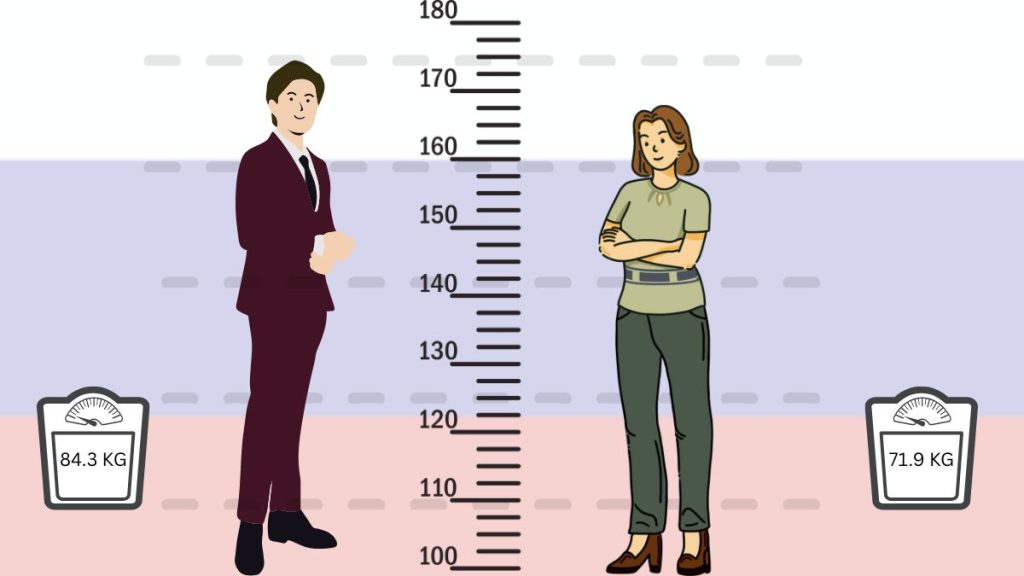Russia’s average adult height is about 177 cm for men and 165 cm for women (2025 country table estimate). Long-run datasets used in 2025 research—particularly NCD-RisC—show a plateau since the late 2010s, so current figures are close to those earlier baselines.
Studies from 2018 to 2021, focusing on the 18-25 age group, show similar patterns. Men in this age range average 176 centimeters and weigh 84.3 kilograms. Women in the same age group measure 164 centimeters and weigh 71.9 kilograms.
These figures are higher than the global average of 163 centimeters for men and 151 centimeters for women. This positions the Russian population well above the global baseline.
This data places Russia’s anthropometric profile among nations with above-average stature. Multiple international research organizations confirm these measurements through cross-referenced studies.
Average Height in Russia: Men and Women Statistics
Russia’s height statistics in 2025 show clear differences between men and women. Health surveys and studies from 2018 to 2021 give us detailed data on adult height. These findings mirror Eastern European trends but also highlight unique Russian characteristics.
| Metric | Men | Women |
|---|---|---|
| Height | 176 cm | 164 cm |
| Weight | 84.3 kg | 71.9 kg |
| BMI | 27.2 | 26.0 |
Research from various initiatives provides insights into height differences by gender. Health agencies and academic groups have collected these measurements using standardized methods.
Male Stature Measurements Across Age Groups
Russian men typically stand between 176 and 177 centimeters (about 5 feet 9 to 10 inches). The 2025 world population estimates found an average height of 177 cm. Studies of men aged 18-25 showed 176 cm, using standard methods.
These figures are consistent across different studies. The narrow range shows reliable data collection across various regions and groups.
Anthropometric profiles go beyond just height. Russian men average 84.3 kilograms in weight, with a body mass index of 27.2. These metrics help us look into the physical characteristics of Russian men.
- Average height: 176-177 cm (5’9″-5’10”)
- Average weight: 84.3 kg (185.8 lbs)
- Average BMI: 27.2
- Primary data sources: 2019 population surveys and 2018-2021 age-specific studies
Female Stature Measurements and Gender Differences
Russian women typically stand between 164 and 165 centimeters (about 5 feet 4 to 5 inches). The 2025 national estimates found 165 cm. Studies of younger women from 2018-2021 recorded 164 cm.
The height difference between men and women in Russia is about 12 centimeters. This aligns with global biological patterns. The male-to-female height ratio in Russia is between 1.07 and 1.08, showing typical sexual dimorphism.

This ratio is consistent across age groups and regions. It provides researchers with reliable benchmarks for demographic and health analyses.
Geographic Variations and Settlement Type Differences
Russia spans eleven time zones, showing significant regional diversity. While detailed regional data in Russia is limited, comparisons with Eastern European neighbors illustrate typical variations.
Ukrainians are generally 4-5 centimeters taller than Russians. Belarusians are closer to Russian heights. These similarities reflect shared genetics and historical development.
Urban and rural differences are also significant. Urban residents in Eastern Europe are typically 2-3 centimeters taller than their rural counterparts. Lithuanian data shows urban military conscripts at 178.4 cm, compared to rural conscripts at 176.2 cm.
| Population Type | Avg Height (cm) | Difference |
|---|---|---|
| Urban Residents | 177.5 | +2–3 cm |
| Rural Residents | 174.5 | Baseline |
These differences are due to better nutrition and healthcare in urban areas. Urban environments offer diverse food sources and medical services during childhood. These factors contribute to height differences in adulthood.
How Russian Height Compares Globally and What Influences It
Height measurements across nations offer insights into development patterns. Russia stands out, reflecting its unique demographic and historical path. These comparisons reveal broader trends in nutrition, healthcare access, and socioeconomic progress over generations.
To understand Russia’s position among developed nations, we must examine current statistics and historical trends. The interplay between genetics and environment creates measurable differences. Anthropologists track these differences across borders and decades.
Russia vs. United States and European Countries
Russia’s height rankings place it in the middle tier among developed nations. Russian men at 177 cm match their United States counterparts exactly. Russian women at 165 cm are 2 cm taller than American women, who average 163 cm according to a 2025 peer-reviewed paper American Journal of Human Biology.
| Country | Male Height (cm) | Female Height (cm) |
|---|---|---|
| Netherlands | 184 | 170 |
| Germany | 180 | 167 |
| France | 179 | 164 |
| UK | 178 | 164 |
| Russia | 177 | 165 |
The Netherlands leads in height measurements, with Dutch men averaging 184 cm and women 170 cm. This makes Dutch men 7 cm taller than Russian men and Dutch women 5 cm taller than Russian women.
Within Europe, Russia population height data shows interesting variations. German men average 180 cm, a 3 cm difference from Russia’s 177 cm. French men measure 179 cm, and British men stand at 178 cm, both exceeding Russian male averages by 1-2 cm as per CDC/Eurostat latest public 2025 data.
Eastern European comparisons reveal closer similarities and some contrasts:
| Country | Men (cm) | Women (cm) | Difference vs Russia |
|---|---|---|---|
| Russia | 177 | 165 | — |
| Belarus | 176 | 164 | ≈ same |
| Ukraine | 180 | 167 | +3 / +2 |
| Poland | 181 | 166 | +4 / +1 |
Baltic populations consistently exceed Russian stature measurements, with men being the most notable. These differences reflect variations in genetic background, dietary patterns, and economic development trajectories across neighboring regions.
Historical Trends in Russian Population Height
The 20th century saw dramatic increases in human stature worldwide, with Russia participating in this trend. While historical data from 1900 is limited, parallel populations show the scale of change.
German men gained about 13 cm over the century. Spanish men increased more than 14 cm, while Iranian men grew over 16 cm. South Korean women experienced the most dramatic change, adding over 20 cm to average height.
Russia likely experienced similar gains during industrialization and the Soviet era. Improved nutrition, expanded healthcare, and reduced childhood disease contributed to stature increases.
Historical disruptions, such as regional famines and World War II, affected growth patterns. These setbacks created measurable dips in anthropometric data that researchers can detect in older population segments.
Key Factors Affecting Height in Russia
Multiple elements determine population stature, influencing both individual lifespans and generations. These factors clarifies why height varies between regions and changes over time.
Genetic predisposition establishes baseline parameters for height within ethnic groups. Russia’s diverse population includes numerous ethnic backgrounds, each carrying distinct hereditary traits that influence stature.
Nutritional standards play a decisive environmental role. Protein-rich diets during childhood and adolescence provide the building blocks for bone and tissue growth. This effect becomes visible over generations as improved food access translates into taller offspring.
- Protein intake during developmental years directly impacts final adult height through bone elongation and muscle development
- Healthcare access affects growth by preventing and treating childhood illnesses that divert energy from physical development
- Socioeconomic status correlates with height through better nutrition quality, cleaner living conditions, and superior medical care
- Chronic disease burden in childhood reduces final stature by redirecting metabolic resources toward illness management

Russia’s healthcare system provides universal coverage that supports healthy development across income levels. Regional disparities in medical facility quality and nutritional access contribute to urban-rural height differences documented in population studies.
These factors work together, not in isolation. A child with tall genetic predisposition needs adequate nutrition and good health to reach that height. Optimal environmental conditions cannot overcome fundamental genetic limitations on stature.
Conclusion
The data shows that Russian men average 177 cm in height, while women average 165 cm. This places Russia above the global average but below Northern European nations. The figures give a national snapshot, but they hide significant regional diversity across the country’s vast geography.
Height demographics in Russia are influenced by genetics, nutrition, healthcare access, and socioeconomic conditions. Urban populations tend to be taller than their rural counterparts. Western regions have different patterns compared to Siberian and Far Eastern areas.
Historical records indicate steady increases in height through the 20th century as living standards improved. Post-Soviet generations have seen continued gains, though at slower rates than previous decades. These trends mirror those in countries undergoing similar economic transitions.
Height is a key indicator for demographers and public health officials tracking population health. It offers insights into nutritional adequacy, healthcare infrastructure, and overall development. Russia’s position in global rankings reflects its status as a developed nation with ongoing challenges in delivering consistent standards across all regions.
The average height in Russia tells a story beyond simple measurements. It provides context for the nation’s demographic profile within both European and global frameworks.
FAQ
What is the Average Height for Men in Russia?
Russian men stand at an average height of 176-177 cm, or about 5 feet 9 inches. This is based on data from the NCD Risk Factor Collaboration and studies on the 18-25 age group. The average weight for Russian men is 84.3 kg, with a BMI of 27.2. This provides a complete picture of their anthropometric profile.
What is the Average Height for Women in Russia?
Russian women average 164-165 cm, or about 5 feet 4-5 inches. This is based on international health research data. They are about 12 cm shorter than Russian men, reflecting the typical gender difference seen globally. The male-to-female height ratio of 1.07-1.08 is consistent with worldwide patterns.
How Does Russian Average Height Compare to United States Height Statistics?
Russian men and American men have similar heights, averaging 176-177 cm. Russian women are slightly taller than their American counterparts. Russia’s height rankings place it between Western European and global averages. This reflects its geographic location and developmental path compared to other industrialized nations.
Are There Regional Height Differences Within Russia?
Yes, there are geographic variations in Russia, though detailed regional data is scarce. Ukrainian populations are 4-5 cm taller than Russians, while Belarusians are similar in height. Urban populations are 2-3 cm taller than rural ones due to better nutrition and healthcare.
How Does Russia Height Compare to European Countries?
Russian men are 3 cm shorter than German men and 7 cm shorter than Dutch men, the tallest globally. Russian women are 1-2 cm taller than French and British women but 4-5 cm shorter than Baltic populations. Russia’s height falls between Northern European peaks and global averages, reflecting its unique demographic and developmental characteristics.
What Factors Influence Average Height in Russia?
Genetic predisposition, nutrition, and healthcare access all influence Russia’s population height. Protein intake during childhood drives height increases across generations. Healthcare affects stature by preventing and treating diseases. Socioeconomic status also plays a role through nutrition and medical care access. These factors interact across Russia’s diverse population to produce observed height measurements.
Has Average Height in Russia Increased Over Time?
Yes, there has been a significant increase in height over the 20th century, though specific Russian data from 1900-2000 is limited. German, Spanish, and Iranian men have seen dramatic gains of 13-16 cm over a century. Russian populations likely experienced similar improvements due to industrialization, better nutrition, and healthcare expansion during the Soviet era. Regional famines and World War II disruptions may have temporarily slowed growth in certain cohorts.
What is the Height Difference Between Russian Men and Women?
Russian men are about 12 cm taller than women, with a male-to-female height ratio of 1.07-1.08. This gender difference aligns with global patterns of sexual dimorphism. The consistency of this ratio across different measurement methodologies and age groups shows Russia follows typical biological patterns in height distribution between sexes.